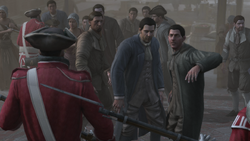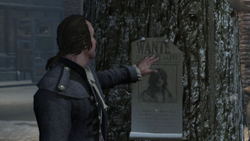This crowd is a powder keg—we can't allow him to light the fuse.Achilles Davenport to Ratonhnhaké:ton, 1770
The Boston Massacre, also known as the Incident on King Street to the British, was the shooting of a crowd of civilian protesters in Boston by British soldiers on 5 March 1770.
Tensions had been boiling over the past years due to several tax acts that the colonists found intolerable. Several fights around the city culminated in a spontaneous mob that gathered in front of the Old State House on King Street, heckling its guards. The Colonial Rite of the Templar Order, seeking to escalate the situation for their own interests, had one of their members, Charles Lee, fire his pistol into the air to provoke the soldiers. Amid the confusion, the guards panicked, opening firing into the crowd against their orders, wounding several people and killing five.
The incident was quickly seized upon by the Patriots' propaganda which characterized it as a deliberate massacre, and it became one of the seminal events of the American Revolution. For the young Assassin trainee Ratonhnhaké:ton—better known as Connor—this incident became his first lesson on social stealth as he was immediately _targeted as a culprit by the Templar Grand Master Haytham Kenway and was forced to hide in the city and escape.
Background
Tell me—who represented us in Parliament? Spoke on our behalf? Signed in our stead? Give me a name! Only you can't! And do you know why? You can't tell me who represented us because nobody did!A Bostonian to a crowd just before the incident

Since the end of the French and Indian War in 1763, British colonists across continental North America had been seething over the passing of several acts on taxation by the British parliament. While these acts were designed to raise desperately needed revenue for United Kingdom, the colonists found them repressive and also took issue with their lack of representation in Parliament.[1][2][3] Previously, the much hated Stamp Act had been repealed after furious opposition by the colonists, and this success inspired the Bostonians to continue resisting further legislation of Parliament.[1]
Incident
I say again: disperse! Congregating in this manner is forbidden!Thomas Preston to the crowd
Nonetheless, the catalyst for the incident that became known as the Boston Massacre was not an act of Parliament but an argument over a wig-maker's bill. With tensions at a high, this set off a mob that took to the streets and began rioting. Hundreds of colonists converged on the Old State House where they trapped eight British soldiers in front of its entrance. During this time, the crowd threw snowballs and stones, insulted the men, and shouted their grievances against the British government. In nearby streets, colonists and soldiers brawled, wrestling one another against walls and snow.[1][4]
The man in charge of the soldiers, Captain Thomas Preston, attempted to defuse the situation by speaking with the crowd to little avail.[1][5] He was asked if his soldiers' muskets were loaded to which he admitted that they were, and the protesters taunted him to open fire.[4] The situation had not yet reached a climax when the Templars determined that it was in their interests to incite chaos and bloodshed from the confrontation. Grand Master Haytham Kenway was present at the scene and ordered his men to position themselves on the rooftops around the square with muskets. They were spotted by Achilles Davenport, Assassin Mentor of Colonial Brotherhood which had been nearly destroyed during the French and Indian War. Achilles instructed his pupil, Connor, to tail the Templar that he had seen receiving orders from Haytham.[1]
This, the teenage Kanien'kehá:ka did without issue, stalking the man to the roof of a building on the south side of the square. Before he could fire his musket, Connor killed him, only for the dying man to direct his attention to another Templar on a roof directly opposite theirs. There, Haytham's protégé, Charles Lee, casually fired his pistol into the air. Down below, the soldiers heard the shot, and thinking that they were about to be slaughtered, they panicked.[1] One among them, Private Hugh Montgomery,[6] shouted "Damn you, fire!", and the soldiers opened fire, killing three immediately and wounding eight more.[1][4][5] Haytham, who had spotted Connor on the roof, pointed the Assassin out to one of the soldiers, marking him as a suspect who had instigated the slaughter with the first shot.[1]
Aftermath
One of the interesting things about the massacre is what happened afterward - that is, how both sides tried to spin it to their advantage.Shaun Hastings' observations on the event, 2012

Following the shooting, two more of the victims died from their wounds, and the incident became the subject of a propaganda war began between the Patriots and the British. One result was the famous engraving of the event by Paul Revere, which depicted an orderly line of British soldiers firing in unison on the unarmed civilians. To the British, the event was the "Incident on King Street", but the popular name of "Boston Massacre" signified that the Americans' characterization largely won out. Because of these major pieces, the event became a symbol of British oppression, as well as a seminal event for the emerging American Revolution in the British colonies.[4]
Prosecutions
Each of the eight soldiers were arrested following the event. Six of them were acquitted, among them Preston, while the other two were found guilty of manslaughter but the usual punishment of death was commuted to a branding of their thumbs. The same wig-maker who had started the initial conflict lowered his prices,[4] but the calamity of the event still bore down on the Patriots, who took the chance to gather more followers for their cause.[5]
Assassins with the Patriots
Connor, still new to Assassin training, was abandoned to his predicament by his master as an impromptu lesson in social stealth. A messenger was sent by Samuel Adams, a leading Patriot, to assist him, and he agreed to meet with Adams at the Faneuil Hall that night. Though the entire city scoured for him, Connor managed to remain hidden until then. Just as Assassins for centuries had learned to reduce their notoriety,[7] so too did Connor learn from Adams the basic tactics of removing wanted posters and bribing heralds. These actions alone would not have been enough to dispel the false rumours, however, and Adams introduced him to the secret network of tunnels beneath Boston that had been built by the Freemasons.[8]
Through these tunnels, Connor could move throughout the city unseen,[9] and as their final destination for the night, they reached a printer's shop, where Adams helped negotiate a revision of the press to exonerate Connor.[10] After this, the Assassin was able to leave Boston by ship and return to the Davenport Homestead.[10] His meeting with Adams had profound effects to come as it signified the beginning of a friendship between the Sons of Liberty and the Assassin Brotherhood.[10][11] Connor's contributions to the American revolutionary cause would prove pivotal throughout the coming war in battles like Bunker Hill,[12] Monmouth,[13] and the Chesapeake.[14]
Behind the scenes
The Boston Massacre features in Assassin's Creed III, comprising the entirety of the memory "A Trip to Boston", where the main protagonist Connor visits Boston for the first time and is caught up in the incident. Unlike in history, the shooting is instigated by eventual general of the Continental Army Charles Lee, who serves as a primary antagonist in the game. In The Art of Assassin's Creed III, the game's scriptwriter Corey May stated that due to the ambiguity surrounding the catalyst for the massacre, the Templars were written into the story as manipulating the historical events for their own agenda.[15]
Inconsistencies
With the exception of the Templars' instigation, the game strives for historical accuracy in regards to the event, with the British character of Shaun Hastings keen on clarifying popular misconceptions in the database.
Despite this, certain details of the game's depiction do not align with the facts presented by Shaun. His account explains it was a soldier being struck by a stone and dropping his musket that set off the shooting.[4] This soldier was, in reality, Hugh Montgomery, the same soldier who shouted the order to fire.[6] In the memory, Montgomery shouts those words immediately upon hearing Charles Lee's gun from a distance, without having been struck by a stone and dropping his musket first. That these two individuals are one and the same are not made clear in the game, but given that they should be, this is a minor detail that conflicts with both the historical account and Shaun's in-universe research.
Since Shaun's database entry is based off of his own research not the memory as witnessed by Desmond Miles, a few explanations exists. First is the possibility that the in-universe historical accounts are identical to those in the real-world but that the detail of Montgomery being struck by a stone was falsified as part of Templar white-washing of their role in the incident. Another is that while the details of Templar involvement were obviously covered-up within the universe, Montgomery was also canonically struck by a stone around the same instant, only that it was omitted as an out-of-universe compression of the events in the game's depiction.
Despite only eleven people being shot during the incident, the number of people found on the ground is completely random, and they move as if they were still alive even though historically three were killed instantly. In some cases, many of the victims on the ground are also women, but only men were shot in the actual event. Notwithstanding this, one of the men killed in the incident was supposed to have been the sailor Crispus Attucks,[5][16] who was of mixed African and Nipmuc heritage, but a civilian of his complexion is not shown in the game with the others on the ground.[1]
Appearances
- Assassin's Creed III (first appearance)
- Assassin's Creed: Forsaken
- Assassin's Creed: Nexus VR (mentioned only)
References
- ↑ 1.0 1.1 1.2 1.3 1.4 1.5 1.6 1.7 1.8 Assassin's Creed III – A Trip to Boston
- ↑ Assassin's Creed III – Database: Stamp Act
- ↑ Assassin's Creed III – Database: Patriots
- ↑ 4.0 4.1 4.2 4.3 4.4 4.5 Assassin's Creed III – Database: Boston Massacre
- ↑ 5.0 5.1 5.2 5.3 Assassin's Creed III – Database: The Boston Massacre
- ↑ 6.0 6.1 Zobel, Hiller B. The Boston Massacre. New York, W.W. Norton & Company, 1970. p. 197.
- ↑ Assassin's Creed II
- ↑ Assassin's Creed III – Boston's Most Wanted
- ↑ Assassin's Creed III – Lying Low
- ↑ 10.0 10.1 10.2 Assassin's Creed III – Stop the Presses
- ↑ Assassin's Creed III – The Tea Party
- ↑ Assassin's Creed III – Battle of Bunker Hill
- ↑ Assassin's Creed III – Battle of Monmouth
- ↑ Assassin's Creed III – Battle of the Chesapeake
- ↑ The Art of Assassin's Creed III
- ↑ Kamensky, Jane, et al. "The Ends of Empire, 1754–1774". Western Civilization. 11th ed., Cengage Learning, Inc., 2017. p. 136.